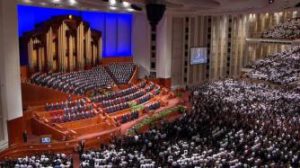Five new temples were announced by the Mormon Church president during his Sunday morning address (April 2, 2017) at the church’s 187th annual General Conference. This brings the number of temples worldwide, operating or under construction, to 182 according to the Mormon newsroom.
Mormonism teaches these temples are a restoration of biblical temples in the last days before Christ’s second advent. Do Mormon temples have ancient biblical parallels? Those of us who have been inside a Mormon temple would be hard pushed to see any parallels between what went on in temples in Bible times and what goes on inside Mormon temples today. What is the history of temples? Of the temples we see in the Bible, which one has Mormonism “restored”?
These temples are costly to build and maintain and demand of Mormons a level of commitment that is exceptional, both in proving worthy to attend and in the sacrifices involved in attending; travel, financial sacrifice, time commitment and physical effort. It is not called temple “work” for nothing. This illustrates a point often overlooked by those who comment only casually on religious issues. Faith is a commitment unlike anything else in life. Of course, there are always those nominal members whose involvement is marginal, but for a great many believers of any persuasion it is a life-defining, heart-felt commitment.
It is worth asking, then, whether our loyalty is wisely placed, our commitment wisely invested. The apostle Paul urged Christians to, “Examine yourselves to see whether you are in the faith; test yourselves” (2 Cor.13:5) Good advice when your faith will shape profoundly your life and determine your eternity. For that is what Mormon temples are about, time and eternity. The Mormon newsroom reports:
Latter-day Saints consider temples to be the “house of the Lord,” the most sacred places on the earth. Temples differ from the meetinghouses or chapels where all are welcome to attend Sunday worship services. In the temple, the teachings of Jesus Christ are reaffirmed through marriage, baptism and other ceremonies that unite families for eternity.
Mormons believe their faith is a restoration of Christ’s New Testament Church and therefore build temples just as Christians did in ancient times. They regard Mormon temples as primarily places of learning and instruction and liken them to the Lord’s university:
‘We learn about our relationship with God. We learn about the purposes of our life here upon the earth. Questions such as where did we come from? Why are we here? What happens to us after we die? Those questions are addressed and answered in the instruction that’s presented in the temple. We also make promises to live
honest, upright and virtuous lives.’ (Elder David Bednar, Mormon apostle)
If this is true then Christians should be building temples. Indeed we should put down whatever we are doing and make every effort to become a worthy temple Mormon – no mean feat I assure you. The temple is at the centre of the Mormon faith, the impression given that temples have always been at the centre of worship for God’s people. But did ancient temples fill the role attributed to them by Mormons and did Christians in ancient times build temples?
Ancient Temples
Temples were plentiful in Ur of the Chaldee, in Mesopotamia, the place Abraham left to follow the Lord (Gen.11:27-12:4) There were many gods and each had a temple.
From the time of Abraham, the patriarchs were nomadic and God appeared to them as and when he pleased, sometimes at the scene of a sacrificial altar (Gen.28:22)
When Israel became a people called out of slavery they had, by God’s command, a central shrine in the desert in the form of a portable tabernacle (Ex.25-30), but during the time of the judges God was still worshipped at different shrines and was not confined to one place (e.g. Shechem Josh.8:30; Shiloh 1 Sam.1:3)
Settled Israel finally built a temple, prepared for by King David (2 Sam.24:18-25) and built by his son Solomon (1 Ki.5-8). After 300 years this temple was sacked by Nebuchadnezzar (2 Ki.25:8,9).
In the 25th year of Israel’s exile Ezekiel saw in vision a temple which is described in some detail (Ez.40-43) but it was never built.
The second temple was built by the returning exiles (Ezra and Nehemiah) and stood for almost 500 years only to be finally destroyed by Pompey in 63 BC.
The building of Herod’s temple was begun in 19 BC but was more an attempt to reconcile Jews to the idea of having an Idumaean king than to glorify God. It took nine years to build, although work continued until 64 AD, finally being destroyed by the Romans in 70 AD.
‘Temple’ in the New Testament
When Jesus came he respected the temple, calling it God’s house (Mt.12:4; Jn.2:16). He cleansed the temple declaring, “My house will be called a house of prayer for all nations” (Mk.11:11-19).
But Israel’s refusal to repent issued in Jesus’ prediction of the destruction of the temple and the whole order that accompanied it (Mk.12:1-12; 13:2). The new temple was to be the congregation of the people of God, Christians (Mt.18:20; Jn. 14:23)
Although early Christians continued to meet at the temple (Acts 2:46; 3:1; 5:12) they were already realising the implications of what Jesus had said about the temple. Stephen, the church’s first martyr, was already reported as having spoken against the temple (Acts 6:11). At his martyrdom Stephen recounted the history of Israel and the temple and concluded:
“However, the Most High does not live in houses made by men. As the prophet says:
‘Heaven is my throne, and the earth is my footstool.
What kind of house will you build for me? Says the Lord.
Or where will my resting place be?
Has not my hand made all things’” (Acts 7:48-51)
Finally, Paul fully develops the idea when he writes:
“Don’t you know that you yourselves are God’s temple, and that God’s Spirit lives in you? If anyone destroys God’s temple, God will destroy him; for God’s temple is sacred, and you are that temple”
(1 Cor.3:16,17, c.f. 6:19)
This idea is especially strong in a later letter:
“What does a believer have in common with an unbeliever? What agreement is there between the temple of God and idols? For we are the temple of the living God. As God has said: ‘I will live with them and walk among them, and I will be their God, and they will be my people’” (2 Cor.6:16)
Since Christians are now the temple of God our lives should reflect holiness (2 Cor.7:1) and we should seek unity in the Spirit (1 Cor.3:5-17). Old Testament language describing the in-gathering of Israel and the nations (e.g. Is.57:19, ‘far’ Gentiles, and ‘near’ Israel) is employed to describe the in-gathering of God’s people from every nation (foreigners and aliens) to be part of God’s household and living temple (Eph.2:13.17,19-22). Here the pictures of the temple and of the body are juxtaposed as Paul describes the temple as being built of believers and those believers being ‘built up’ and “growing up into him who is the Head, that is, Christ. From him the whole body, joined and held together by every supporting ligament, grows and builds itself up in love, as each part does its work” ((Eph. 4:12,16).
The thought is carried on in 1 Peter 2:4-10, where the apostle tells believers, “You also, like living stones, are being built into a spiritual house to be a holy priesthood, offering spiritual sacrifices acceptable to God”, with the addition of the priestly and sacrificial elements of the OT temple being redefined in the Christian life.
Shadow and Reality
In Ex.25:8 we read that the tabernacle in the desert was made after a pattern revealed by God. In Hebrews we read that this sanctuary is, “a copy and a shadow of what is in heaven” (Heb.8:5). The true sanctuary is the heavenly one (Heb.9:24), which Christ entered as our Great High Priest (v.23, 24). This sanctuary belongs to the people of the new covenant (Heb.6:19, 20) and because Christ has “appeared once for all at the end of the ages to do away with sin by the sacrifice of himself” our souls have hope as an anchor (Heb.9:26; 6:19)
“Just as man is destined once to die once, and after that face judgement, so Christ was sacrificed once to take away the sins of many people; and he will appear a second time, not to bear sin, but to bring salvation to those who are waiting for him” (Heb.9:27,28)
The temple was part of a sacrificial system that was a shadow of a heavenly pattern. A shadow that pointed to the once for all sacrifice of Christ, his entering the true heavenly sanctuary on our behalf, and the building of a temple made without hands, comprised of the people of God being built up and growing into their Head, who is Christ; A temple of people drawn from near and far, Jew and Gentile, in whom God dwells by his Spirit, and who exercise a royal priesthood in offering sacrifices of praise.
Mormon Temples in the Bible
Abraham left behind a temple-building culture to follow the Lord. These were the famous ziggurats, of which the Tower of Babel is the most famous (Gen.11:4). They symbolised man’s self-confidence and pride, “Come let us build ourselves a city, with a tower that reaches to the heavens, so that we may make a name for ourselves…” Gen.11:4). They were man-made stairways to heaven. The names of other such structures reflect this attempt by man to reach up to heaven, “The House of the link between Heaven and Earth” at Larsa; “The House of the Seven Guides of Heaven and Earth” in Borsippa; “The House of the foundation-Platform of Heaven and Earth” at Babylon; “The House of the Mountain of the Universe” at Asshur.
These all reflected man’s attempts to reach the heavens by his own effort, achieve his own renown and a dominant godlike status. The temples of Mormonism are described as:
“…primarily places of learning and instruction and like…the Lord’s university: ‘We learn about our relationship with God. We learn about the purposes of our life here upon the earth. Questions such as where did we come from? Why are we here? What happens to us after we die? Those questions are addressed and answered in the instruction that’s presented in the temple. We also make promises to live honest, upright and virtuous lives.’”
Joseph Smith said:
“Here, then, is eternal life – to know the only wise and true God; and you have got to learn how to be gods yourselves…the same as all gods have done before you” (Journal of Discourses, Vo.6. p.4 1844)
Mormon temples have their pattern in the Bible, but it is not after the pattern of heaven but of Ur of the Chaldees. 182 modern Ziggurats designed that man may make a name for himself, learn to be a god and exercise dominion.




